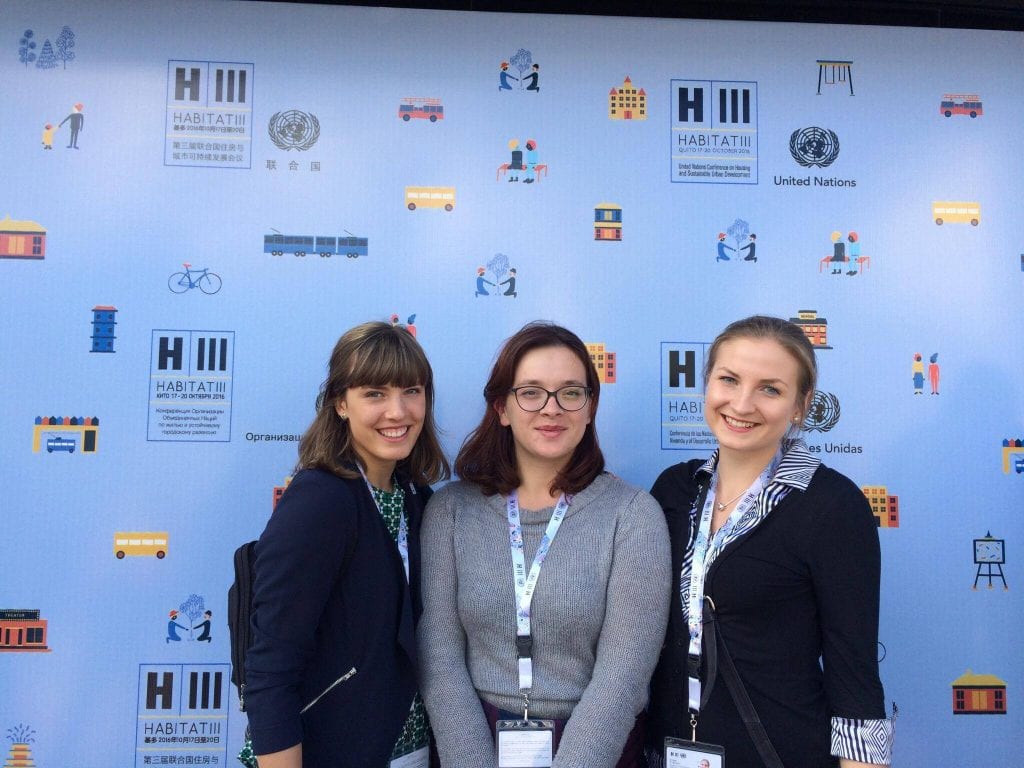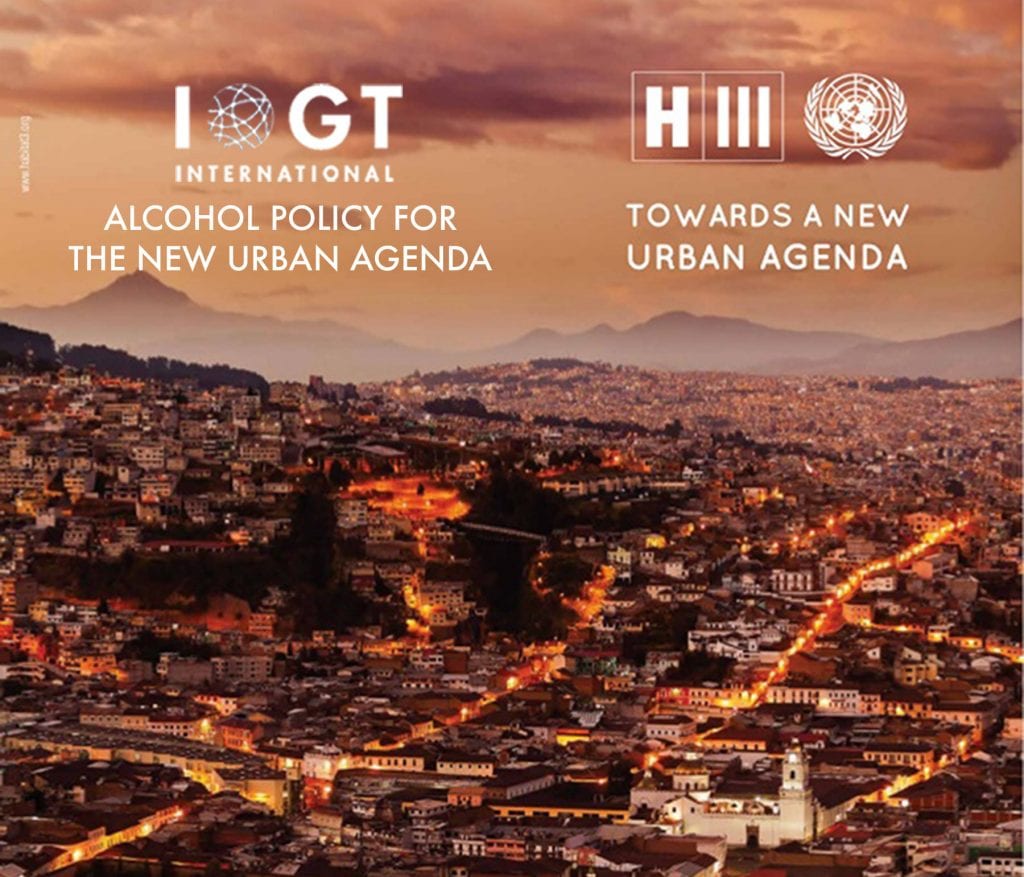55. That’s a number. And it’s an exclamation mark. 55% of the world’s population is already living in urban areas. Throughout this century the trend will pick up even more speed. In near future a substantial majority of the world’s population will be living in urban centers.
Therefore, cities and urban centers are and will be crucial for tackling and solving the biggest global challenges, such as climate change, the epidemic of Non-communicable diseases or the global burden of alcohol harm.
For these reasons, we are in Quito, Ecuador at the Habitat III conference these days. We, that is three rockstar members of IOGT International: Saga, Freja and Mimi. Habitat III is the United Nations Conference on Housing and Sustainable Urban Development.

Saga, Mimi, Freja in Quito, Ecuador
Towards a New Urban Agenda
The Habitat III Conference is the global forum for decision-makers and opinion leaders to gather and discussion solutions for how to improve urban development. Habitat III has as its mission the adoption of a New Urban Agenda.
The Conference is a unique opportunity for rethinking the Urban Agenda in which governments can respond by promoting a new model of urban development able to integrate all facets of sustainable development to promote equity, welfare and shared prosperity,” says Dr. Joan Clos the Secretary-General of the Habitat III Conference. He is also the Executive Director of UN-Habitat, at the level of Under Secretary General of the United Nations since October 2010.
The New Urban Agenda (PDF) is a landmark document outlining a set of concrete actions and global standards of achievement in sustainable urban development. It is really ambitious to in attempting to foster a rethinking of the way humanity builds, manages, and lives in cities.
The vision of the New Urban Agenda is
… of cities for all, referring to the equal use and enjoyment of cities and human settlements, seeking to promote inclusivity and ensure that all inhabitants, of present and future generations, without discrimination of any kind, are able to inhabit and produce just, safe, healthy, accessible, affordable, resilient, and sustainable cities and human settlements, to foster prosperity and quality of life for all.”
In two key words, the New Urban Agenda envisions “cities for all” as well as “cities of justice, safety, health and resilience”. Much needs to be done to achieve this vision. And alcohol is a major obstacle to both building cities for all and creating cities of justice, safety, health and resilience.
Alcohol obstacle for the New Urban Agenda
The New Urban Agenda is set to be the catalyst for an urban paradigm shift.
The new approach to urban development will be sustainable, people-centered, age- and gender-responsive and integrated. It’s about boosting social inclusion, ending poverty, creating opportunities for all, and building public space for health.
For all this, alcohol harm is a massive obstacle. The pervasive presence of alcohol makes public spaces less safe, less inclusive, less enabling and less diverse. Especially youth and women are excluded from life happening in the public realm because of alcohol-induced risks.
Alcohol harm excludes youth
Our Member Organization UNF conducted a representative YouGov survey among Swedish youth between 16 and 19 years of age to find out about whether public spaces are fostering inclusion and health. What became clear: alcohol causes exclusion and ill-health.
- 21% of adolescents say they only use alcohol because there is nothing else to do during leisure time
- 87% of adolescents agree that alcohol makes public space unsafe. 80% say alcohol-free public space feels safe.
- 55% of adolescents say they stay away from public space because of alcohol.
- High density of alcohol outlets is associated with increased binge use and a range of alcohol harms, such as violence, road traffic injuries or sexually transmitted infections.
Alcohol harm confines, threatens women
Studies and focus groups give a clear picture: the pervasive presence of alcohol in the public space is a Women’s Rights issue because women are at great risk of suffering from violence due to alcohol in the public space. Evidence shows:
- Australia: 40% of all cases of physical and/ or sexual assault of women are alcohol-related.
- Europe: 29% of alcohol users in European nightlife used alcohol specifically to facilitate sexual encounters.
- India: infamous gang rape perpetrators are frequently under the influence of alcohol.
- High density of alcohol outlets is associated with increased binge use and a range of alcohol harms, such as violence, road traffic injuries or sexually transmitted infections.
All these facts tell the story of urban development being hindered by alcohol harm. It’s a story of exclusion, lack of opportunity and freedom, oppressions and vulnerability – the opposites of the paradigm shift that global leaders actually want to bring about with the New Urban Agenda.

Alcohol policy is part of the solution
In the context of an ambitious vision for urban development and an urgent need to create cities for all, cities of justice, safety and health, alcohol policy measures are crucial tools.
- Limiting alcohol availability and creating more alcohol-free zones,
- Regulating alcohol affordability, and
- Banning alcohol advertising and sponsorships are the best buys for helping to boost urban development that puts people at the center; for urban development that does not leave anyone behind; for urban development that creates opportunities and freedom for everyone, no matter the gender and age.
Evidence-based alcohol policy measures help creating better urban spaces.
INCLUSIVE PUBLIC SPACE. HEALTHY YOUTH
- Prevent alcohol harm
- Foster young people’s growth
- Shape young people’s identities as active citizens
- Promote meetings with new people, perspectives
- Experience community and civic engagement
- Practice engaging with other opinions
- Practice expressing thoughts and opinions
- Provide youth with agency
- Strengthen democracy
It’s true, alcohol policy measures have the potential to unfold a myriad of interconnected positive effects for urban development – especially if they are rooted in community and youth advocacy.
SAFE PUBLIC SPACE. LIBERATED WOMEN
- Prevent alcohol harm
- Promote Women’s Human Rights
- Facilitate equal opportunity
- Remove obstacles for female agency
- Prevent and reduce gender-based violence
- Improve public discourse
- Strengthen local communities
- Strengthen democracy
Women and girls suffer disproportionately from the harm caused by alcohol in urban settings. Lack of safety and the floating of social norms put women in peril. Local alcohol policy measures therefore do have potential to reduce and prevent gender-based violence and in doing so facilitate equal opportunity and strengthen local communities.
For these reasons, alcohol policy has to be a corner stone of the implementation of the New Urban Agenda in cities around the world. In Quito, Saga, Mimi and Freja have engaged in numerous conversations and discussions to raise awareness about this fact. After Habitat III it’s for all of us in the global IOGT movement to build on their work and start similar conversations in our communities.
Alcohol policy measures help to build cities for all.
—
For further reading
Booklet: Alcohol and the New urban Agenda
Fact sheet: All dressed up and nowhere to go
The New Urban Agenda, September 10, 2016 version (PDF)